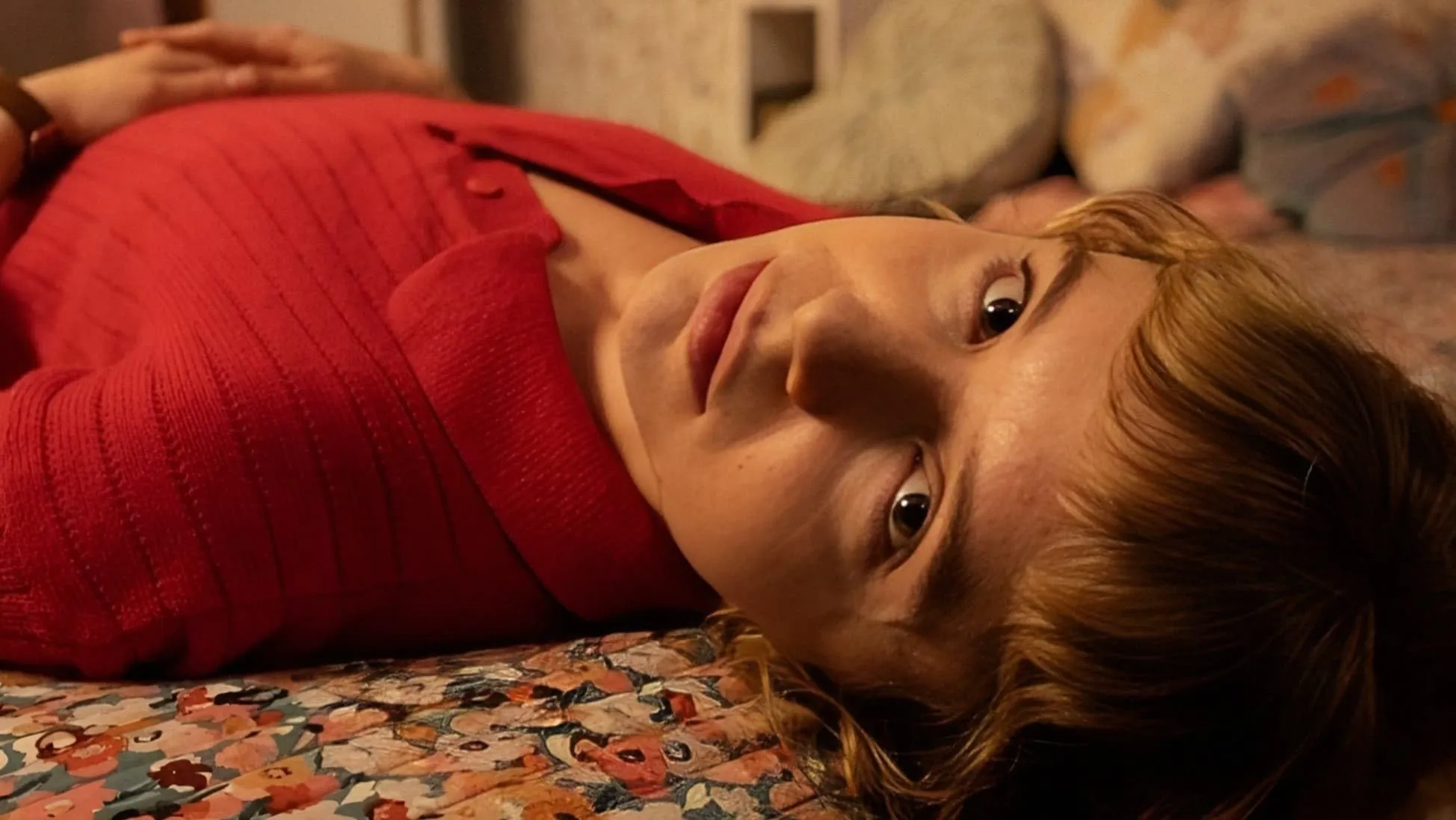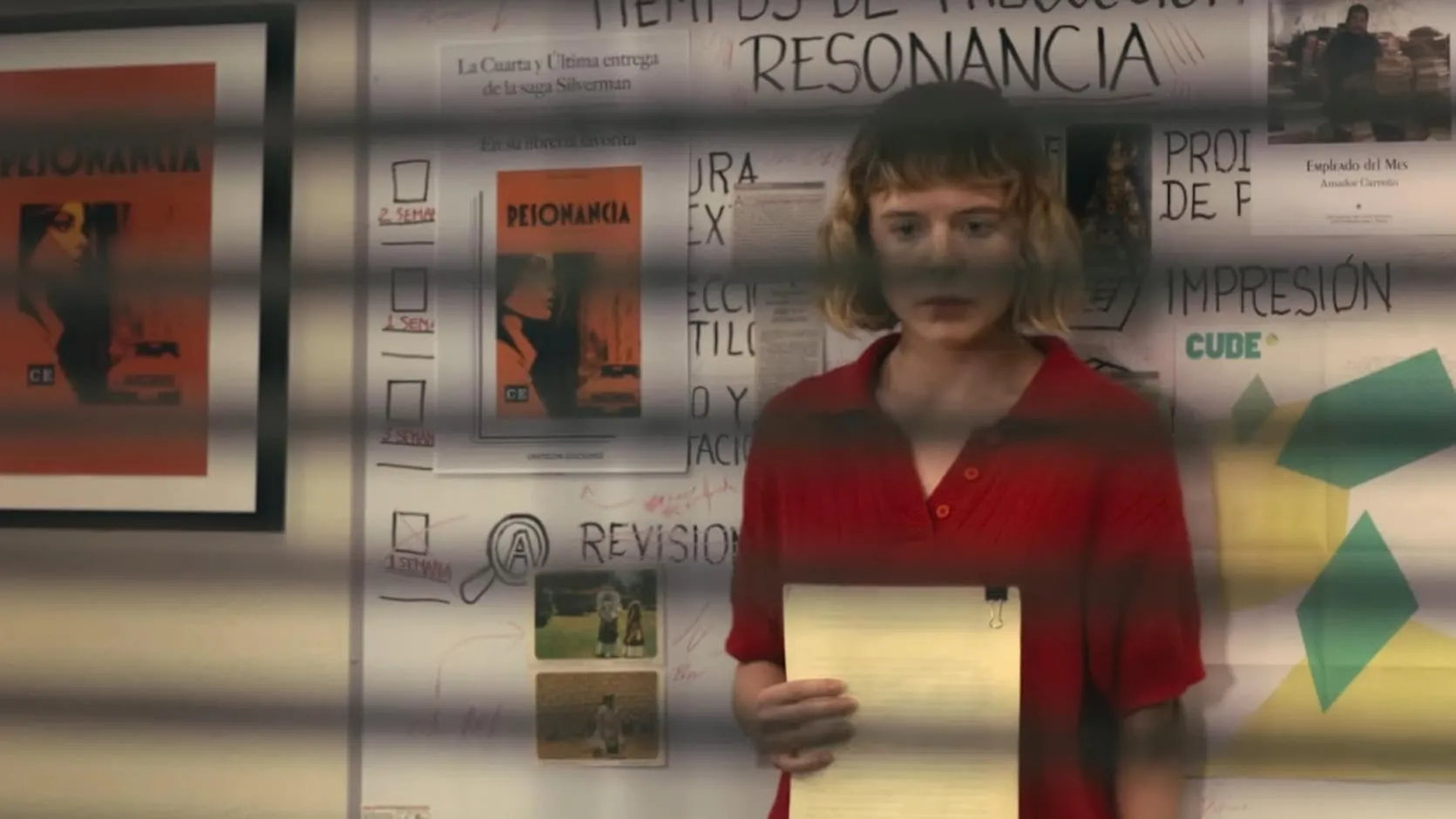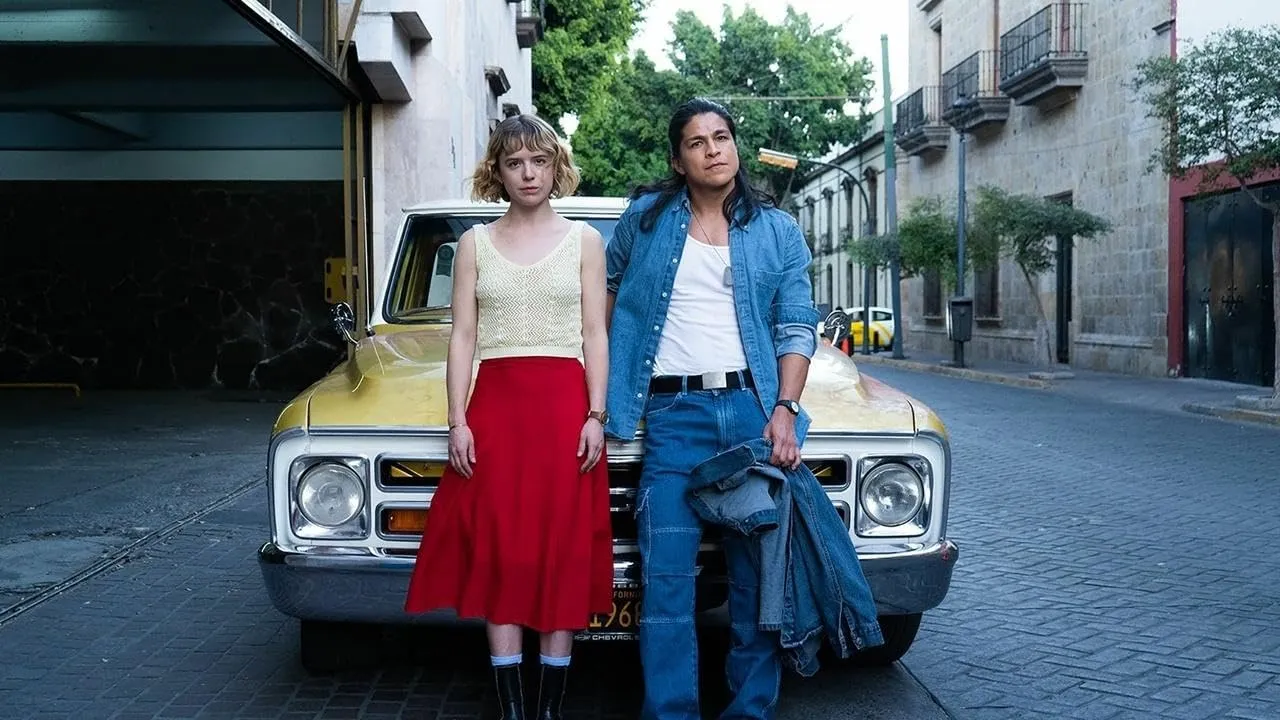Corina inhabits a few blocks in Guadalajara, her life measured in paces between home, a corner store and a dimly lit publishing basement. Years of inherited agoraphobia left by her mother’s trauma have sculpted her existence into rigid routines: correcting pulp romance manuscripts, stepping homeward along familiar sidewalks, counting each tile underfoot. This repetition gains texture through the film’s whimsical narration, which drapes her small world in gentle irony and moments of hushed tension.
When Corina clandestinely rewrites a bestselling author’s bleak ending, she ignites change that shatters her safe perimeter. That manuscript edit both mirrors and defies her cultural roots—rooted in a Mexican neighborhood where gratitude for her late father’s legacy earned her this low-level job, yet daring to reshape a narrative she’s only ever followed. Visual storytelling techniques—vibrant attire against industrial gray offices, close framing that barely contains her—underscore how identity and environment collide.
By focusing on these shifts, the film speaks to global audiences familiar with tales of self-discovery while remaining grounded in regional specificity. Corina’s voice-over recalls literary traditions of omniscient narrators, yet her experience feels particular to Guadalajara’s sun-bleached streets. In this interplay of personal constraint and emerging agency, the film invites us to consider how stepping beyond invisible lines might redefine who we are—and what stories we choose to tell next.
Unraveling Patterns: Corina’s Narrative Threads
The film opens with a hushed voice-over tracing Corina’s childhood trauma, overlaying her adult footsteps as she navigates familiar sidewalks. This flashback establishes both the origin of her agoraphobia and the narrative’s rhythmic counterpoint between past and present. The catalyst arrives when Corina, acting on impulse, rewrites a bestselling author’s bleak finale—an act that shatters her controlled routine.
As the altered manuscript circulates, her sheltered life fractures: coworkers praise the new ending even as she grapples with guilt. The rising action unfolds through her growing awareness of consequences—each step beyond her block feels weighted with risk. In the climactic stretch, Corina resolves to cross that yellow curb line, setting off in search of the author whose voice she momentarily borrowed. The film’s resolution finds her not at a neat endpoint but standing on a wider street, hinting at personal breakthroughs and possibilities awaiting her.
Fear versus agency. Corina’s agoraphobia manifests as both physical limitation and mental barrier. Each hesitated breath before a doorway underscores how fear can confine a life. Her manuscript rewrite becomes an allegory for self-authorship—choosing to shape a narrative rather than remain its passive subject.
Writing and self-expression. Copyediting pulp romances mirrors Corina’s wish to edit the story of her own life. Her bold decision to alter another’s words signals a shift from silent observer to active creator.
Empathy and human connection. Encounters with café owner Fernanda, cousin Carlos and office colleagues illustrate how small gestures of kindness loosen Corina’s isolation. Trust emerges gradually: a nod, a shared coffee, a quiet conversation—all building toward newfound rapport.
Set against Guadalajara’s sun-faded façades, local color seeps into each scene. Murals, street vendors and tiled walkways ground Corina’s journey in place. The film borrows Amélie’s narrative whimsy—voice-over reflections, visual flourishes—yet swaps Parisian romance for a Mexican meditation on self-reliance. Here, the community’s warmth counters urban anonymity, offering Corina both comfort and challenge. By weaving regional textures into a universal tale of overcoming fear, the film bridges its Mexican roots with global audiences seeking stories of quiet courage.
Embodied Voices: Performance Across Borders
Norvind’s portrayal relies on subtle physical precision: a trembling hand when she hesitates at doorways, a tightened jaw in moments of panic. Her facial micro-expressions—an upward flicker of the eyebrow or a fleeting downcast glance—speak volumes where dialogue cannot. When Corina finally finds her voice, Norvind adjusts her pace, shifting from clipped, cautious syllables to more assured tones. This measured vocal delivery charts Corina’s arc from silent observer to emerging author of her own story, reflecting Mexican performance traditions that prize restraint before release.
Politi balances warmth with overprotectiveness, her comforting gestures tinged with undercurrents of fear. She offers humor—a soft chuckle over Corina’s obsessive step counting—then pivots to quiet concern, her posture closing off when discussing the outside world. This interplay of tenderness and anxiety shapes Corina’s emotional landscape, revealing how inherited values of familial duty in Mexican society can both support and confine.
Fernández sidesteps conventional romance tropes, instead embodying a supportive confidant whose presence steadies Corina’s trembling steps. Their chemistry unfolds in shared silences—a knowing nod as Corina edges past a curb line; a gentle hand guiding her through a crowded street. His dialogue is casual yet purposeful, each line crafted to bolster her agency. Through this rapport, the film highlights how community bonds in Latin American culture create safe spaces for vulnerable growth.
Lili, the no-nonsense publisher, punctuates narrative tension with clipped directives, her impatience underscoring corporate pressures. Xareni Silverman appears in brief, enigmatic scenes that contrast Corina’s open expression with the author’s guarded reserve. Café owner Fernanda offers local color—her warm invitations and animated gestures evoke neighborhood camaraderie. Each figure illuminates facets of Corina’s journey: professionalism versus artistic impulse, isolation versus communal encouragement, tradition versus self-determination—showing how individual transformation is shaped by the cultural mosaic surrounding her.
Chromatic Truths: How Corina Sees Her World
Corina’s world unfolds in a deliberate clash of hues. Within the basement office, walls and desks recede into muted grays, mirroring corporate rigidity. Her clothing—bold reds and pinks—stands apart, as if plucked from a Mexican folk painting, signaling personal color in an otherwise drab environment. As she ventures beyond her block, the palette shifts: soft greens and earth tones seep into the frame, reflecting Guadalajara’s sunlit courtyards and lush plant life. This visual arc recalls Wong Kar-wai’s use of saturated color to capture internal states, though here the shift feels rooted in regional light rather than expressionist exaggeration.
Close framing dominates Corina’s confined space. Tight two-shots and extreme close-ups trap her in the frame’s edges, accentuating small fidgets—a hand brushing hair aside, a tightening grip on manuscript pages. When she crosses that yellow curb, lens choice widens to reveal expansive skies and open plazas. Those wider shots echo Terrence Malick’s painterly vistas, yet remain anchored by urban textures: patterned tile, ornate ironwork, bursting bougainvillea.
Within her comfort zone, the camera stays locked on tripods, composition balanced and orderly, reflecting cultural values of structure and respect for personal rituals. At moments of decisive change, handheld movement introduces subtle shake, as if the viewer holds her shoulder. Lens flares and occasional rack focus pay homage to contemporary Latin American cinematography, where technical flair underscores emotional beats.
Lighting design follows a parallel arc. Fluorescent yellows hum beneath office ceilings, creating a sense of artificial safety. As Corina steps outdoors, tungsten warmth gives way to ambient daylight, soft shadows moving across façades. These choices reveal how light can map a character’s inner expansion—and suggest how local visual traditions can resonate with audiences across cultural lines.
Harmonic Borders: Soundscapes of Corina’s World
An omniscient voice-over guides Corina’s steps with measured cadences, echoing Latin American literary traditions that blend storytelling and introspection. Its gentle rhythm punctuates her internal monologue—each hesitation lingers under the narrator’s calm emphasis, drawing listeners into her silent anxieties.
Gus Reyes and Andrés Sánchez layer percussive motifs that mirror Corina’s uncertainty: staccato rhythms during her routine, shifting to broader, resonant patterns as she crosses new thresholds. These thematic cues—hand drums for tension, swelling strings for moments of resolve—reflect musical influences from Mexican folk percussion while nodding to cinematic scoring practices found in global auteur cinema.
Within her block, ambient street sounds—vendors calling, distant traffic—form a comforting loop that underscores her confinement. Occasional muffled footsteps and muted storefront chatter evoke a sonic barrier. In scenes of tentative exploration, these effects drop away, replaced by near silence or soft wind rustles, emphasizing her isolation amid open spaces.
Corina’s soft-spoken lines often blend into ambient hum, forcing viewers to lean in, replicating the challenge she faces when speaking beyond her comfort zone. Strategic dips in volume suggest both literal inaudibility and the character’s struggle to be heard—a design choice that aligns narrative and sound to convey her emerging voice across cultural and cinematic borders…
Textured Time: Design That Speaks
Corina’s apartment feels like a lived-in scrapbook: pink-hued walls lined with postcards from distant cities, shelves crowded with mementos that recall her father’s literary passions. This intimacy contrasts sharply with the publishing house basement, where exposed pipes and concrete floors evoke an industrial anonymity. The corner café and nearby storefronts, however, bring local vibrancy into view—handpainted signage, woven baskets of produce, framed by sun-faded awnings that root the story in Guadalajara’s streetscape.
Turn-of-the-millennium technology—clunky CRT monitors, rotary phones—anchors the film in an analog era just before digital ubiquity. Manuscript pages printed on dot-matrix–style paper feel tactile, reminding viewers of a time when edits required pencil strokes rather than cursor clicks. Street signs use period typography, while stray cassette tapes and floppy disks tucked into desk drawers suggest a transitional moment in communication history.
Corina’s ensemble—sturdy boots, flowing maxi skirt and precise bob haircut—blends practicality with stylized poise. Her reds and pinks signal both caution and inner warmth, shifting to warmer greens when she ventures beyond safety. Supporting characters offer contrast: Lili’s tailored suits communicate corporate discipline, while café owner Fernanda’s loose cotton blouses and embroidered aprons reflect regional artisanal traditions.
Manuscript pages marked with Corina’s pencil edits become extensions of her voice, each crossed-out line a small act of rebellion. The yellow curb line painted on sidewalks serves as a constant visual motif—an invisible script that both confines and challenges her. Through these design elements, the film weaves cultural textures into every frame, making setting itself a storyteller.
Echoes of Courage: Emotional Resonance Across Cultures
Corina’s timid steps across familiar streets become universal gestures of bravery. Viewers, whether in Guadalajara or Tokyo, recognize the weight of quiet resolve as she edges beyond her threshold. Each small act—pressing a fingertip to sidewalk paint, inhaling before a doorway—yields emotional payoff, inviting us to honor our own tentative advances into the unknown.
Moments of playful whimsy—a narrator’s wry observation, a splash of unexpected color—sit beside undercurrents of grief inherited from loss. This duality echoes narrative techniques found in both Mexican magical realism and Japanese slice-of-life dramas, where laughter and sorrow coexist without jarring tonal shifts.
Corina’s inherited trauma and her push toward self-liberation mirror global conversations around mental health and intergenerational healing. Her story resonates with anyone confronting fears shaped by family history or societal pressures, whether in São Paulo’s crowded avenues or Berlin’s quiet courtyards.
A close-up on Corina’s widened eyes as morning light floods her apartment; the echo of her voice-over as she counts rebellious steps; the lingering shot of manuscript pages scattered on a café table—these beats crystallize her transformation. Like a resonant chord in world cinema, they linger long after the credits roll…
Full Credits
Director: Urzula Barba Hopfner
Writers: Urzula Barba Hopfner, Samuel Sosa
Producers: Urzula Barba Hopfner, Carlos Hernández Vázquez, Iván López Barba
Cast: Naian González Norvind, Cristo Fernández, Carolina Politi, Mariana Giménez, Laura de Ita, Gerardo Trejoluna
Director of Photography (Cinematographer): Gerardo Guerra
Editor: José Villalobos Guerrero
Composers: Gus Reyes, Andrés Sánchez Mahler
The Review
Corina
Corina offers a gentle meditation on overcoming fear through small acts of bravery, vividly grounded in Guadalajara’s streets and enriched by Naian González Norvind’s expressive performance. Its vibrant visuals, thoughtful pacing, and emotional warmth create a film that feels both intimate and universal.
PROS
- Vivid color contrasts that mirror Corina’s emotional shifts
- Expressive nonverbal performance by Naian González Norvind
- Rich cultural detail rooted in Guadalajara’s streets
- Close framing and sound design that convey anxiety
- Voice-over narration adds literary depth
CONS
- Film’s pacing stalls in episodic midsections
- Supporting characters receive limited development
- Narration occasionally overshadows visual storytelling
- Final act follows familiar narrative patterns
- Themes beyond personal fear remain lightly sketched





















































